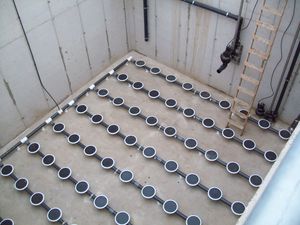
Wastewater treatment plant PURE - DN®
Add to favorites
Compare this product
Description
The dissolved organic materials in the wastewater are transformed into carbon dioxide, water and biomass by microorganisms. Continuous aeration is required for this technology via fine bubble deep aeration units. The quantity of the input oxygen can be controlled via measurements by an oxygen probe; aeration is programmable for denitrification and for lowest energy consumption. This two or multi-lined system is easy to operate and provides technological flexibility and operational safety. Thus the system and WTTP can easily and effectively manage increased hydraulic capacity demands due to growing population and sewerage connections. More lines mean higher operational security in case of sludge bulking.
Organic matter in wastewater is converted by microorganisms into carbon dioxide, water and biomass. For the technology to work, continuous aeration must be provided by means of a fine-bubble deep aeration unit. The amount of oxygen to be ingested can be controlled by measuring an oxygen probe. A two or more line system provides operational safety and technological flexibility. Thus, in the case of a new sewerage network, due to the gradually increasing residential connections, the wastewater treatment plant can receive and efficiently handle the changing hydraulic load. Multiple lines also mean a higher level of operational safety in the event of sludge spinning.
ANOXIC BASIN
AEROBIC BASIN
TREATED WATER AND SLUDGE SEPARATION: SECONDARY CLARIFIER
NITRATE RECIRCULATION
CHEMICAL DOSING FOR PHOSPHOROUS REMOVAL PURPOSES
SLUDGE REMOVAL
Catalogs
No catalogs are available for this product.
See all of Pureco Ltd.‘s catalogsRelated Searches
- Filtration system
- Liquid filtration system
- Water purification unit
- Absorption filtration unit
- Automatic filtration system
- Water filtration system
- Wastewater treatment plant
- Activated carbon filtration system
- Ultra-filtration unit
- Liquid ultra-filtration unit
- Membrane ultra-filtration unit
- Pre-treatment unit
- Biological wastewater treatment plant
- Wastewater water purification unit
- Ion exchange water purification unit
- Wastewater ultra-filtration unit
- Process water ultra-filtration unit
*Prices are pre-tax. They exclude delivery charges and customs duties and do not include additional charges for installation or activation options. Prices are indicative only and may vary by country, with changes to the cost of raw materials and exchange rates.







